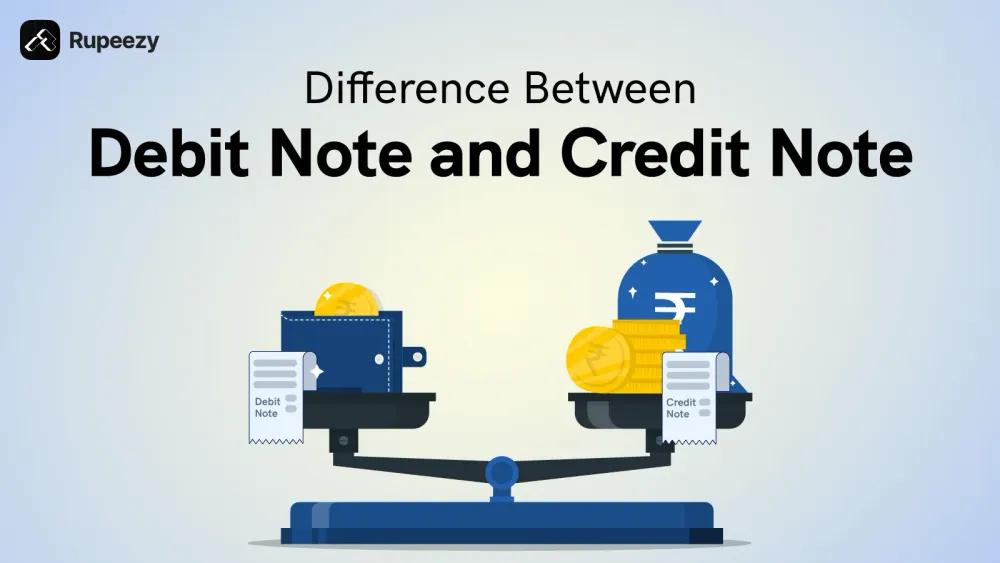Difference Between Debit Note and Credit Note


00:00 / 00:00
Debit and credit notes are two very important instruments for tracking financial transactions between businesses. The buyer sends a debit note when they return goods or are overcharged. It shows how much the supplier’s account will be debited. On the other hand, a credit note is issued by the seller, and it shows how much credit the buyer will receive for the goods they returned.
You have to understand how they differ because it will help you manage financial records accurately. You will be able to avoid confusion or errors in billing. These notes are crucial for effective financial management, especially when adjusting transaction amounts. But before we get to the difference between debit and credit note in GST, let's see what each means in detail.
What is a Debit Note?
A debit note is a commercial document a buyer issues to the seller to inform them that an amount will be debited from their account. This document typically includes details like a description of the goods, the amount they will debit, and the reason for the debit, such as returned goods or overcharges. When they issue a debit note, the buyer officially records the amount that will be reduced from the seller’s account in their books.
Types of Debit Notes
Here are the different types of debit notes used in different scenarios:
Goods return debit note: This is issued when a buyer returns products to lower the total amount they owe the seller.
Tax discrepancy debit note: This notifies taxpayers about any differences found in their tax obligations to request that they settle the amount they owe.
Adjustment debit note: This is used to fix mistakes or inconsistencies in previous billing documents.
Purchase price debit note: This is created when the buyer seeks a reduction in the purchase price due to issues like defective items or mistakes in pricing.
Interest debit note: This is sent to borrowers to inform them of interest that has accumulated on loans or credit.
When to Use a Debit Note
The buyer issues a debit note in these situations:
Overcharging: If a buyer notices they were charged too much, they issue a debit note to correct the seller's account.
Returns: When a buyer returns products, they send a debit note to reduce the amount owed to the seller.
Undercharging: If the seller has undercharged the buyer, the buyer issues a debit note to inform the seller about the correct amount to be charged.
When a buyer uses a debit note in these cases, they maintain clear records and ensure both businesses have accurate financial adjustments. Now, let's get to know more about credit notes.
What is a Credit Note?
A credit note is a document the seller sends to a buyer to show that the buyer is entitled to a credit. This credit can come from quality disputes, returning goods, invoicing errors, order cancellations, or changes in price. The aim is to adjust the amount the buyer owes in order to ensure accurate financial records and fair transactions between both parties.
Types of Credit Notes
Just like debit notes, here are the types of credit notes:
Return credit note: This is issued when buyers return products and want to receive a credit for the amount.
Price adjustment credit note: This is used when buyers request a lower price for items due to issues like defects or incorrect charges.
Shipping adjustment credit note: This one is to address any changes needed in shipping fees when discrepancies arise in the billing.
Discount adjustment credit note: This reflects any agreed-upon discounts, decreasing the total amount owed on the invoice.
Service adjustment credit note: This is used to amend service fees, fix any errors in previous billing or acknowledge extra services provided.
When to Use a Credit Note
A credit note is used in several situations:
Overcharging: If a buyer accidentally overpays, the seller issues a credit note to adjust the buyer's account.
Returned goods: When the seller receives items back from the buyer, they issue a credit note to confirm that the buyer's account is credited with the returned amount.
Undercharging: If the seller has undercharged the buyer, the seller can issue a credit note to adjust the buyer's account and reflect the correct amount owed.
Difference Between Debit Note and Credit Note
Aspect | Debit note | Credit note |
Definition | A document the buyer issues to indicate the seller owes some amount. | A document the seller issues to show that the buyer's account has been credited. |
Issuer | Buyer to the seller. | Seller to buyer. |
Purpose | Request a higher payment from the buyer for various reasons. | Confirms a reduction in the amount the buyer owes, usually for refunds or adjustments. |
When used | For issues like undercharging or extra fees. | For scenarios like product returns, pricing errors, or adjustments in billing. |
Impact | Increase in the buyer's total outstanding amount. | Decrease in the buyer's total outstanding amount. |
Implication | Leads to an increase in the buyer's debt. | Results in a decrease in the buyer's debt. |
Settlement process | Future payment obligation from the buyer. | May lead to a refund or a lower payment from the buyer. |
Journal entry | Debit in the buyer’s account. | Credit in the buyer’s account. |
Why it is used | - To notify about additional costs. - To adjust an invoice that was underbilled. - To add fees for late payments. | - To issue a refund for returned goods. - To note damage adjustments for products. - To correct a previously overcharged amount. |
Accounting effect | An increase in the seller's accounts receivable. | A decrease in the seller's accounts receivable. |
Check out these fictional scenarios to understand the two better.
For Debit Note
Let’s assume a company, TechGadgets Inc., sold 100 laptops to another company, Gadgets World, for Rs.40 lakh. After reviewing the invoice, Gadgets World realizes they were mistakenly charged for 10 extra laptops. To address this, Gadgets World issues a debit note to TechGadgets Inc. for Rs.4 lakh, requesting that their account be debited by this amount. With this document, TechGadgets will be notified that Gadgets World will adjust their payment to reflect the accurate order quantity.
For Credit Note
Now, consider the opposite situation with a company, HomeDecor Co. and another, Designs Unlimited. Designs Unlimited purchases some furniture from HomeDecor Co. for Rs.12 lakh. Unfortunately, some items arrive damaged. Designs Unlimited returns these damaged pieces and receives a credit note from HomeDecor Co. for Rs.2.5 lakh. This credit note reveals that Designs Unlimited’s account will be credited by that amount. It will reduce their total outstanding balance with HomeDecor.
GST Impact on Debit and Credit Notes
Debit notes and credit notes are crucial in managing GST liabilities. When a credit note is issued under Section 34(1) of the CGST Act, it indicates that the supplier needs to lower their tax liability. For example, if a buyer returns goods or if the invoice value is higher than the actual amount, the supplier must issue a credit note. This action helps adjust the GST filings, as it automatically populates in the buyer's GSTR 2A to ensure an accurate tax report.
On the other hand, a debit note, as per Section 34(3) of the CGST Act, is used when a supplier needs to increase their tax liability. This occurs in cases like underbilling or when the tax charged is lower than what it should be. Suppliers must also report debit notes in their GSTR 1.
You have to understand that if the recipient accepts a credit note in their GSTR 2, the supplier can reduce their tax liability accordingly. Conversely, if a debit note is issued, the recipient must accept it to adjust their tax input. Debit and credit notes in GST ensure that both buyers and sellers maintain accurate tax records to prevent discrepancies in GST filings.
Difference Between Credit Note and Debit Note in GST
Aspect | Debit note | Credit note |
GST liability | Increases the supplier’s GST liability, as the supplier must account for the additional tax. | Reduces the supplier’s GST liability, as the supplier needs to adjust the tax charged previously. |
Reporting | Must be reported in GSTR 1 for the month of issuance and will auto-populate in GSTR 2A. | Also reported in GSTR 1 and impacts the buyer's GSTR 2A once accepted by the recipient. |
Issuer | Typically issued by the supplier when there’s an underbilling or additional charges. | Usually issued by the supplier when goods are returned or if the buyer has been overcharged. |
Conclusion
You will manage your finances effectively when you understand debit and credit notes. Debit notes increase the amounts owed when there are additional charges, while credit notes reduce the amounts owed due to returns or overcharges. Knowing how to manage these notes helps you keep accurate records and comply with GST regulations.
To simplify your financial transactions, check out Rupeezy. As a leading discount stock broker and trading platform, Rupeezy provides valuable support in managing your financial statements and notes. Take control of your finances today with Rupeezy to get smooth business or personal finance transactions.
FAQs
What is debit note in simple words?
A debit note is a document from a seller to a buyer to inform the buyer of an amount they owe, often used in business transactions before the official invoice.
What is a credit note in simple words?
A credit note is a document from a supplier to a buyer. It reduces the amount the buyer owes and is often issued when goods are returned, or there are billing mistakes.
What is debit note and credit note accounting entry?
When a debit note is issued, the account that owes money is credited, and the person receiving the note is debited. For a credit note, the opposite happens: the account receiving the credit is debited, while the person’s account that owes money is credited.
Check Out These Related Articles |
The content on this blog is for educational purposes only and should not be considered investment advice. While we strive for accuracy, some information may contain errors or delays in updates.
Mentions of stocks or investment products are solely for informational purposes and do not constitute recommendations. Investors should conduct their own research before making any decisions.
Investing in financial markets are subject to market risks, and past performance does not guarantee future results. It is advisable to consult a qualified financial professional, review official documents, and verify information independently before making investment decisions.

All Category










